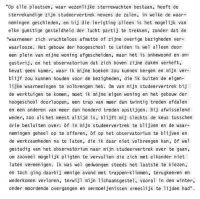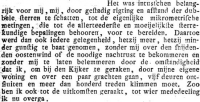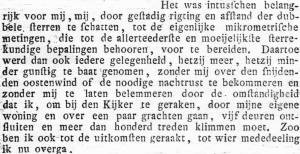Table of Contents
Frederik Kaiser
Sources: Frederik Kaiser (1808-1872): Schepper van de 'nieuwe' Leidse Sterrewacht, Huib Zuidervaart, Frans van Lunteren, Hans Hooijmakers, David Baneke en Dirk van Delft (2011)
Trivia
- Date of birth: 10-06-1808, Amsterdam
- Date of death: 28-07-1872, Leiden
- Spouce: Aletta Barkey
- Children:
Early life
Frederik Kaiser was born on the 10th of June 1808 in Amsterdam. His father, Johann Wilhelm Kaiser (1769-1818) was originally from Nassau-Dietz but had moved to the Hague as a hatter. Shortly after, he moved to Amsterdam to work as a clerk and later on as a teacher of the German language. He also wrote his own book that could be used for teaching German and was the owner of a Dutch-German library in the kalverstraat. He was married to Anna Sibilla Liernur (1778-1870) who was a jeweler's daughter. They got 6 children together, with “Friedrich”, also called “Frederik” or “Frits” as their eldest.
Jan Frederik Keijser, Frederik's uncle
Unfortnuately, Frederik lost his father at the young age of 10 years. This meant that his mother stayed behind with 6 small children and almost no money to live from. Because of this, Jan Frederik Keijser (1766-1823), Johann's eldest Frederik's godfather, took custody of Frederik and treated him as if he were his own.
At the age of 8 Kaiser lost his father. His uncle Johan Frederik Keyzer who worked as a private teacher in math and astronomy took custody over Kaiser from that moment on. Kaiser couldn't have wished for a better teacher since his uncle was a very good hobby astronomer. Professor Moll of Utrecht even said that with his modest means, Keyzer did a lot of research that the universities of the Netherlands had neglegted to do. Unfortunately Keyzer died at the age of 46 when Frederik was just 15 years old.
Kaiser comes to Leiden
 Thanks to the influence of his uncle, Frederik got a position as observer at the university of Leiden. This happened in the following way. Visiting foreign astrophysicists often visited the 'old Keyser'. Among them was the English astrophysicist Edgeworth. Back in England, Edgeworth met with Gerard Moll, a professor of astronomy in Utrecht, the Netherlands. At this meeting they spoke of the young Kaiser. Edgeworth considered him a promising young talent, who should be in civil service.
Back in the Netherlands, Moll met with Kaiser, which led to Kaisers recommendation to the 'administrator of the public education', Van Ewijck, who inform the curators of the Leidse Hogeschool [sub-university level]. Kaiser was then appointed observer at the Leidse Sterrewacht. Around the same time, professor C. Ekama died, and was succeeded by lector Uylenbroek, who, like Ekama, had to monitor the astronomy department. Uylenbroek did not think Kaiser was the right man for the job, and insisted on watching his every move. This difficult relationship caused a lot of delays, as Kaiser, who was a nervous fellow by his very nature, did not feel free to do as he pleased.
Thanks to the influence of his uncle, Frederik got a position as observer at the university of Leiden. This happened in the following way. Visiting foreign astrophysicists often visited the 'old Keyser'. Among them was the English astrophysicist Edgeworth. Back in England, Edgeworth met with Gerard Moll, a professor of astronomy in Utrecht, the Netherlands. At this meeting they spoke of the young Kaiser. Edgeworth considered him a promising young talent, who should be in civil service.
Back in the Netherlands, Moll met with Kaiser, which led to Kaisers recommendation to the 'administrator of the public education', Van Ewijck, who inform the curators of the Leidse Hogeschool [sub-university level]. Kaiser was then appointed observer at the Leidse Sterrewacht. Around the same time, professor C. Ekama died, and was succeeded by lector Uylenbroek, who, like Ekama, had to monitor the astronomy department. Uylenbroek did not think Kaiser was the right man for the job, and insisted on watching his every move. This difficult relationship caused a lot of delays, as Kaiser, who was a nervous fellow by his very nature, did not feel free to do as he pleased.
The observatory was a rather neglected department at that time. It existed, but that was it. The most important instrument, the telescope, was unusable, for instance. This instrument was made by the Frisian (northern Dutch province) telescope builder Rienks, and was given to the observatory by King Willem I. However, Rienks was quite probably not as able a telescope maker as he was made out to be, so the observatory had a bad but very expensive telescope. The rest of the instruments was either old or severely damaged. The quality of the instruments was, in fact, so bad that Kaiser was forced to use his uncles instruments instead. The first eleven years, matters continued like this. Kaiser never really like to talk about this 'useless' period of his career.
Popularization of astronomy in the Netherlands
 At the beginning of the nineteenth century, there was very little public interest in astronomy. The appearance of two comets in 1807 and 1811 changed this a little. In 1833 Kaiser published a translation of the book that Littrow wrote about a comet that was discovered in 1826. The book was meant to reassure the general public, because people were afraid the comet would come near the earth. The translation became very popular and the translator also got a bit of fame. In 1834, Kaiser published anther book, this time about the comet Halley, that would appear in 1835. In this book was an accurate calculation of the comet's orbit and a prediction of its visibility, among other things. With this book Kaiser became really famous.
At the beginning of the nineteenth century, there was very little public interest in astronomy. The appearance of two comets in 1807 and 1811 changed this a little. In 1833 Kaiser published a translation of the book that Littrow wrote about a comet that was discovered in 1826. The book was meant to reassure the general public, because people were afraid the comet would come near the earth. The translation became very popular and the translator also got a bit of fame. In 1834, Kaiser published anther book, this time about the comet Halley, that would appear in 1835. In this book was an accurate calculation of the comet's orbit and a prediction of its visibility, among other things. With this book Kaiser became really famous.
Of course, Kaiser couldn't wait to observe the comet himself. This was not possible in the observatory however, so Kaiser borrowed a telescope from a befriended amateur astronomer. He put the telescope in his own house (running the risk of collapsing the roof) and even removed some roof tiles for this. From all around the country people came to Kaisers house to look at the comet, some of whom were influential people from The Hague. The fact that they had to look at the comet at Kaisers house with a borrowed telescope made them realise something had to be done about the alarming state the observatory was in.
For his efforts and achievements Kaiser was appointed doctor honoris causa in astronomy and mathematics, but the greatest reward was his appointment as lector in practical and theoretical astrophysics and director of the observatory in 1837. Kaiser about his apopintment: “From that day on the revival of astronomy in my homeland was my mission in life.” Kaiser started with the fulfillment of his mission by complaining to the government about the condition of the observatory.
Even though this gets him some new instruments, the poor location of the observatory remains unaltered and Kaiser has a hard time putting them properly in the rickety observatory. Even so, Kaiser does some commendable work on binaries.
During this period, education in astronomy also blooms. Kaiser did not only give lectures to students but also lectures about popular astronomy to members from other faculties and non-students. He put a lot of effort in making astronomy comprehensible for common people. He achieved this by using as little mathematics as possible in his lectures. Kaiser spoke and wrote with a lot of enthusiasm and humour and a tremendous passion for his profession. In this period he published a lot of books, like 'De Sterrenhemel' (1844), and 'Geschiedenis van de ontdekking der planeten'. Especially the first one made a big impression, to the point that it was even known abroad and readers started buying their own telescopes.
Lobbying for a new observatory
Kaiser realised that the improvements in the observatory were not enough to put astronomy in- and outside the Netherlands on the map. Whenever he could, he complained about the decayed state of the building, the unhealthy environment and the vibrations from the street and the bell tower that disrupted the observations. In 1853 Kaisers complaints were finally acknowledged. The Eerste and Tweede Kamer [the upper and lower houses of the Dutch parliament] discussed the idea of a new observatory, but refused to invest any money in the project. In response to this, the curator of the Leidsche Hogeschool, mister Gevers van Endegeest, called on the Dutch citizens to make a donation for the new observatory. The first ones to contribute were the students. The student associations as well as individual students contributed a lot. Professors also contributed a lot and it wasn't long before all around the country commissions were formed to collect money. They collected 26,000 guilders in total, which was not enough by far (the estimated budget was 90,000 guilders), but now the government could no longer be passive. When the new minister of internal affairs, mister G. Simons (and a student of astronomer Moll) put a proper budget on the project there was finally some real progress. The budget was approved of by the Dutch parliament in 1857 (with the new minister of internal affairs A.G.a. van Rappard) but building the observatory outside the city would cost too much money, which meant a part of the botanical garden had to be sacrificed. This introduced a major conflict between Kaiser and the professor of biology, mister Suringar. Kaiser observed in the new observatory from 1864 until 1872. In 1868 he published the first part of the records of the observations at the new observatory. Shortly thereafter, in 1871, he fell ill. The second and third part of the records is also by his hand, but he has never received the published version of the third one. Frederik Kaiser died at the 28th of July, 1872.
Kaiser is not entirely self-educated, because he learned a lot from his uncle and during his time in Leiden he also went to classes. However, he formed the education and research in practical astrophysics on his own accord. When he had just become the director he had to teach himself a lot about (practical) astrophysics, because the government wouldn't fund a trip abroad to learn a thing or two. Kaiser helped to achieve that astrophysics is no longer a subsidiary field, but become more esteemed than it had ever been before. The public appreciation of his work becomes apparent in the popularity of his books and lectures and the incredible willingness of the people to collect money for the new observatory. With an unbelievable drive and unstoppable enthusiasm, Kaiser conquered all the setbacks that he had to endure and achieved his life goal: the revival of astronomy in the Netherlands. With the help of some influential friends he managed to lift astronomy to a whole other level.
By: Sascha Zeegers
Death
[ ]Kaiser died in 1972 and was buried in the Groenensteeg graveyard on spot number 400.
His gravestone is badly worn and hard to recognize, but still very much there.
]Kaiser died in 1972 and was buried in the Groenensteeg graveyard on spot number 400.
His gravestone is badly worn and hard to recognize, but still very much there.
Kaiser stukjes
Anecdotes and Stories
When in 1835 Halley’s comet was visible in the skies, many prominent people came to Leiden for the event. They were under the impression that Kaiser would show them the comet at the Observatory, but they were instead lead to the house of Kaiser himself. There Kaiser had set up a telescope on loan, which was of much higher quality than those at the Observatory. But in order to set up the telescope in his house, Kaiser had to make a hole in his roof. The people who came to see the comet truly realized now that something needed to be done about the instrumentation at the Observatory. Before Kaiser moved to the directors house he lived nearby on the Cellebroersgracht (filled up and now Kaiserstraat), now restaurant “Verboden Toegang”, and later in the house right of the entry gate of the Academy.
[ ][
][ ]
]
F. Kaiser
Frederik Kaiser (1808-1872) was a son of a German middle class emigrant in Amsterdam. He came to Leyden when he was 18 and became observator under physics professor Uylenbroek. Uylenbroek was a competent man, but unhappy when this autodidact was parachuted on an assistant position mean for physics. The 10 year under Uilenbroek were not happy ones for Kaiser. But he struggled on, predicted the of the return of the comet of Halley with great precision. Halley He contacted influential people to witness it, and got rewarded with an honorary doctorate in 1835. In 1838 he became director of the observatory, still housed on the Academy building.
He married Aletta Barkey en got 5 children. His son Pieter Jan also got involved in astronomy and wrote a thesis on astronomical photography. Pietr Jan succeeded him later as director of the Verification Institute for Marine Equipment. The brother of Kaiser, Johann Wilhelm, became director of the Etching School, and professor of the National Academy of Arts. In 1973 he also became director of the National Museum. He made the first stamp of the Netherlands and of Indië. The famous Hendrik Lorentz attended lectures of Frederik Kaiser. Lorentz married Aletta Catharina Kaiser, the daughter of Johann Wilhelm in 1881.
Kaiser took every opportunity to emphasis his need for a better observatory. In 1845 he writes about that.
 Kaiser not only observer and teacher, but was also popularizer. Lecturing everywhere and writing popular books. He had the strong opinion that exact and abstract matters are things of the mind. As such his publications are almost devoid of any diagrams. A bit strange for astronomy.
Kaiser not only observer and teacher, but was also popularizer. Lecturing everywhere and writing popular books. He had the strong opinion that exact and abstract matters are things of the mind. As such his publications are almost devoid of any diagrams. A bit strange for astronomy.
Kaiser was complaining a lot. Partly because of his character, partly because he was in poor health. He had closed TBC. All his life he doubted whether all was worth while after all. [attachment]
 Getting part of the Hortus was not whitout strugglewith the acting director of the Hortus, the botanicus W.F.R Suringar. Kaiser was rector magnificus at the time, but that was not a sign of ambition, with such a small scientific staff, every professor had to take that post some time.
Getting part of the Hortus was not whitout strugglewith the acting director of the Hortus, the botanicus W.F.R Suringar. Kaiser was rector magnificus at the time, but that was not a sign of ambition, with such a small scientific staff, every professor had to take that post some time.
Kaiser did not believe in reflectors so he chose solely refractors. Kaiser lived in exciting times. E.g. the asteroids had just been discovered (Ceres in 1801), filling the gap between Mars and Jupiter. Neptune was discovered on 1846 (by the way: Galileï also unknowingly put Neptune on a map). The first parallax of a star (61 Cygni) was measured by Bessel in 1818. Putting a scale on the stellar universe.
[ ]
In that stage of science Kaiser choose positional astronomy as central object of study.
That meant astrometry for star catalogues, proper motions, minor planets, time service and the like. Later he became keenly interested in photography (his son wrote his these on that).
]
In that stage of science Kaiser choose positional astronomy as central object of study.
That meant astrometry for star catalogues, proper motions, minor planets, time service and the like. Later he became keenly interested in photography (his son wrote his these on that).
The only flaw was that the successor of Kaiser went on along the same lines for forty years. Just in the period that physics, and specifically spectroscopy, made an enormous leap forward. Without the efforts of Kapteyn in Groningen and Minnaert in Utrecht astronomy probably would not have flourished like it did. Biography Kaiser 2011 Obituari Kaiser by Oudemans 1875






